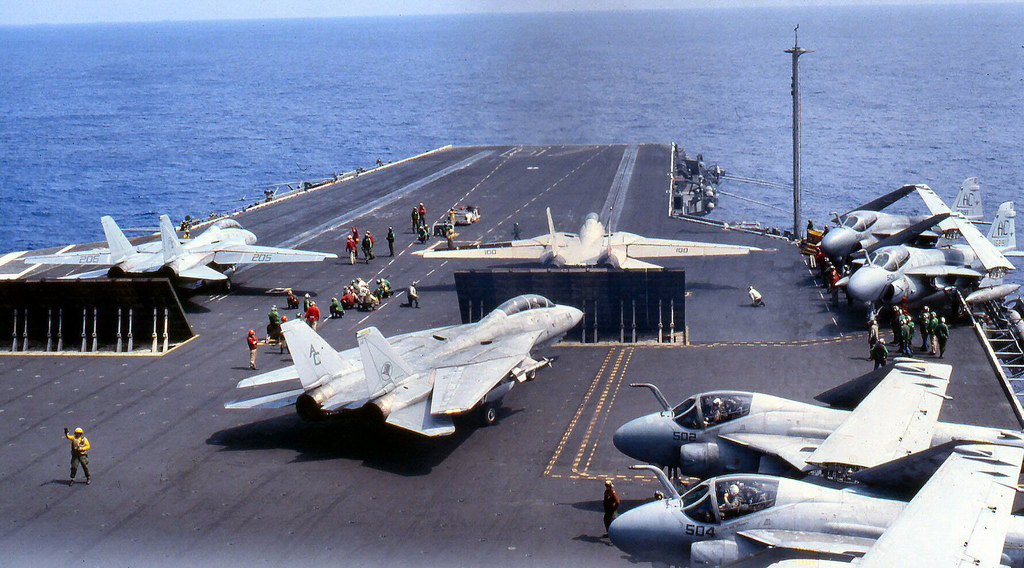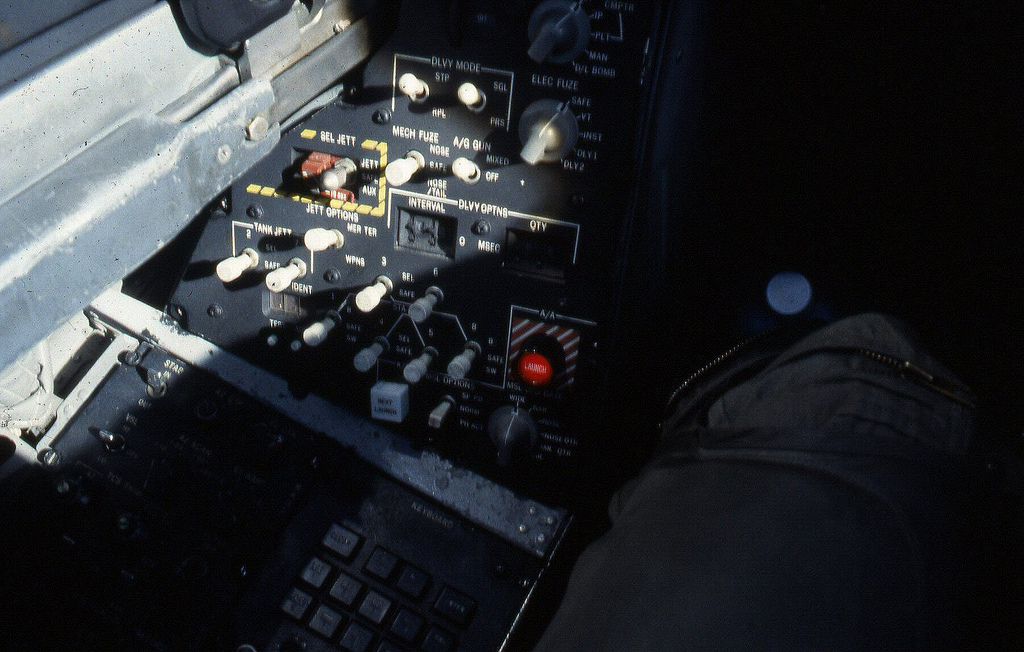“The F-14 Tomcat was a pure air-to-air fighter and our mission, in the words of Manfred von Richthofen (the Red Baron), was ‘…to patrol our area of the sky and shoot down any enemy aircraft that are in that area. Anything else is rubbish,’” Bill “Pinch” Paisley, former F-14 RIO
“The platform was the F-14 Tomcat, the ship was the USS John F Kennedy and the squadron was the VF-14 Tophatters. The mission, in the words of Manfred von Richthofen (the Red Baron), was ‘…to patrol our area of the sky and shoot down any enemy aircraft that are in that area. Anything else is rubbish.’ The Tomcat was a pure air-to-air fighter then, only becoming a fighter bomber in the years after,” says former F-14 Radar Intercept Officer (RIO) Bill “Pinch” Paisley in his cool book 99 Camelots, Fighter Squadron Fourteen, 1987-1990.
As Pinch explains 99 Camelots “is a collection of my personal Tophatter memories as seen through the lens of my camera during the three years I had the privilege of serving with the best group of warriors one could hope for.”

As Paisley reports in his book of all the training environments faced by a Tomcat crew, one of the most challenging was “FFARP. Also known as the Fleet Fighter ACM Readiness Program. It was about a 2-week program where your squadron would go thru a series of escalating scenarios against both scripted and unscripted (but extremely wily) enemy air capabilities, ultimately ending up in numerous air combat sessions as the ‘war’ escalates.”
Pinch and his pilot Dave “Doc” Hicks were in the middle of one of these dogfights, specifically one where they were up against an unknown number of bad guys. “Could be you and your wingman against a similar number of ‘enemy’ aircraft (2 versus 2), or you, alone and unafraid against an unknown number of bad guys (1 versus unknown). The idea, of course, is that you never really knew what to expect ‘out there so you must tailor your tactics based on what you know and what you don’t know.”

One of the things that U.S. Naval Aviators who must use their aircraft to the very limit of their capability learn is how best to fight their aircraft. According to Paisley “this no limited, of course, to which weapon use, but rather includes intimate knowledge of things like what the best speed is in each phase of the fight, what the capabilities are of the expected enemy aircraft, what the best turning speeds and rates are, what the max G’s are in any part of this flowing dynamic called air combat maneuvering, any number of a dozen or more factors that oftentimes determine life or death in an aerial duel.”
As Pinch explains the Tomcat had two “dogfight radar modes” where the crew could command the radar to go into an automatic-lock routine where the first thing it comes across in its scan volume would get locked on. “Typically, when you became engaged in a dogfight (or ACM – air combat maneuvering), the pilot might call for VSL high (or low), or Vertical Scan Lock-on, which would put the radar into a concentrated scan volume and would go to a single-target track lock on the first thing that entered into its scan.” But as Paisley recalls the interesting aspect to this was that the switch to activate VSL was placed on the left-hand side console. “Down just to the left of where my G-suit encased thigh was, and consisted of a toggle switch about an inch high. Surrounded by other toggle switches about an inch high. Needless to say, not a very easy switch to find in normal circumstances, let alone in the hectic world of a dogfight. Yes, as you become more experienced in the management of your cockpit duties finding such seemingly obscure yet important switches and knobs and controls become easier, and ingenious ‘fixes’ were thought up to assist in the usage of this particular switch-such as cutting a small 3″ piece of stiff plastic tubing to put over the switch so instead of looking down and searching for this minuscule thing, all you had to do was sweep your hand over in that direction and you’d hit that plastic extension and activate VSL mode. This particular plane we were in did not have such advanced technology, however, so I had to do the hunt and peck routine anytime we needed that particular ACM radar mode.”
Back to the furball Pinch and Doc were “in this one particular FFARP evolution, probably 1 v 2 (us against other aircraft), and as the good, dutiful radar intercept officer, I was watching our backside (“Six is clear, Doc”!) as he was pushing the fight on one of the bad guys – meaning the other one was still out there somewhere. I just had to find him.”

Pinch found the second bogey shortly after Doc had “shot down” the first A-4 Skyhawk. “I caught sight of the other still – alive bogey, off the right side, a little high, not quite nose on to us. It was important to get Doc’s eyes on the A-4 as soon as possible, so my call to him was short and succinct – ‘Right 2 o’clock, a little high!'[…] That call told Doc to get his eyes over to the right side of the aircraft, look just a bit to the right of the nose (12 o’clock being dead ahead, so 2 o’clock will be right of that), and a little above the horizon. Crew coordination is one of the things we work on incessantly in the Tomcat, and as soon as I made that call to Doc, I knew exactly what he was going to do and I knew exactly what I needed to do. He was going to roll the aircraft to the right and get lift-vector (the ideal aerodynamic position in the longitudinal plane of the jet to put the best G force on the aircraft) on the bogey and pull like crazy to get our nose on the target, and I would reach down and hit the VSL high switch to get the radar in that dogfight mode to try and get a lock.”

But as Paisley turned his head down and to the left to find the VSL switch, Doc rolled the aircraft right and snapped a rather significant amount of G on the aircraft in getting the jet moved around to face a new threat. Which for Pinch meant his head “leaning down and looking to the left side console for this idiotic little inch-high switch, instantaneously became fused with and part of my left knee. I can’t remember exactly how much G we pulled in that maneuver. I met up with Doc at the 2006 Tomcat Sunset at Oceana and we chatted about this hop. He doesn’t remember anything more than the standard Tomcat limit of 6.5 G. I remember something well in excess of that. Whatever it was, it was a lot.”
However, Pinch was able to hit the VSL high switch, as he recalls. “I wrestled with getting my head back up into a more elevated environment (by now I was past my knee and down around my ankles, I think), and getting my eyes back into the fight. VSL locked on, we got a good shot off and killed the second bogey rather expeditiously and by then it was time to head back to Oceana and down the jet for overstress. And wonder if i should call a chiropractor. Doc had no problem – he was set and ready for such a maneuver, while I, even though I knew what was coming, still had to look for that damn switch.”

Anyhow, as Paisley concludes, “we didn’t get into too much trouble when we got back (overstresses are expected sometimes in this training regime – note: the manufacturer’s, Grumman, advertised “g” limit on the aircraft was higher than 6.5, but the Navy dropped it to this lower limit to extend service life on a rather pricy investment), but we did get told that if we did it again, the next flight would be without G-suits.”
Photo by Bill “Pinch” Paisley

